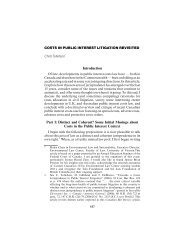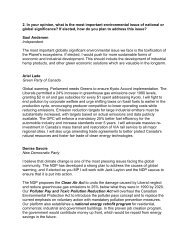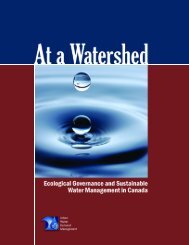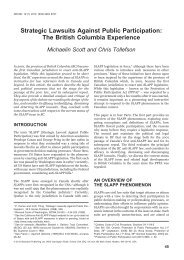Peeling back the Pavement - POLIS Water Sustainability Project
Peeling back the Pavement - POLIS Water Sustainability Project
Peeling back the Pavement - POLIS Water Sustainability Project
Create successful ePaper yourself
Turn your PDF publications into a flip-book with our unique Google optimized e-Paper software.
The transformation of a Stormwater City into a Rainwater City<br />
requires taking three crucial steps...<br />
…that will result in four tangible outcomes.<br />
Build it Better<br />
Improved Runoff Quality<br />
Let Rain Do <strong>the</strong> Work<br />
Reduced Runoff Volume<br />
New Governance<br />
Enhanced Asset Management<br />
<strong>Water</strong>shed Governance<br />
BOX 3: WHAT’S IN A NAME?<br />
Stormwater management is <strong>the</strong> most common term used to describe <strong>the</strong><br />
controlling of runoff with conventionally built drainage facilities. As described<br />
throughout this handbook, this approach is narrowly focused on a handful of<br />
annual rainfall events and fundamentally views runoff as a problem. Its solution<br />
emphasizes getting water off <strong>the</strong> land via hard infrastructure, such as drains and<br />
pipes. The transition to a Rainwater City requires a new way of thinking and doing<br />
that starts with changing <strong>the</strong> way we think and talk about managing rainfall. For<br />
a sustainable world, <strong>the</strong> mission should be to integrate rainwater into planning,<br />
instead of just managing runoff. With this approach, stormwater management<br />
becomes rainwater management, and a simple shift in focus opens a world of<br />
innovation and possibilities.<br />
16<br />
17












